| Short cuts : | Home | Contents | Photos | Ramblings | Contacts | Whats new | : : : | : : : |
Well over a year ago, in "The Works" bookshop chain, I chanced upon a series of books by an American author then unknown to me - Laurie R. King. I was intrigued by her concept - it's 1915, and a young 15 year old American orphan by the name of Mary Russell is being looked after by an aunt on a farm in the UK Sussex Downs, goes for a walk, and bumps into none other than the great Sherlock Holmes. I knew from the Arthur Conan Doyle, Sherlock Holmes series that Sherlock had indeed "retired" to the Sussex Downs to tend bees. The books were in a "three for a fiver" offer, so I bought the first three books in the series, and put them on my "books waiting to be read" shelf. I was then reading and enjoying the original Sherlock Holmes stories, and I though I had better finish these before looking at what Laurie R King had to say.
Laurie King was born in 1952 in Oakland, California. In 1977 she graduated from the University of California, Santa Cruz with a degree in comparative theology. The same year she married the historian Noel Quinton King, and they had two children, Zoe and Nathan. Sadly Noel died in early 2009. Laurie now lives in Watsonville, still in California.
Laurie is an award winning author who has not only penned the Mary Russell / Sherlock Holmes series, but has also written books under the pseudonym "Leigh Richards".
I think I sort of sit on the fence over the ethics of one author adopting / or is it pinching another author's character. I have enjoyed R.H.Wingfield's DI Frost novels both under the original author, and also as recreated by James Henry. Henry's Frost is less coarse, and more like the character in the UK TV series. On the other hand Sue Grafton , who knew she was dying of cancer, made it clear that she wanted her character Kinsey Millhone to die with her, and I think her wishes should be respected. Obviously, if a well loved character is recreated by another author and trashed, then that is wrong. But perhaps it's OK for a gifted author to recreate another's character if its done well, and sympathetically. As I said, I am not sure.
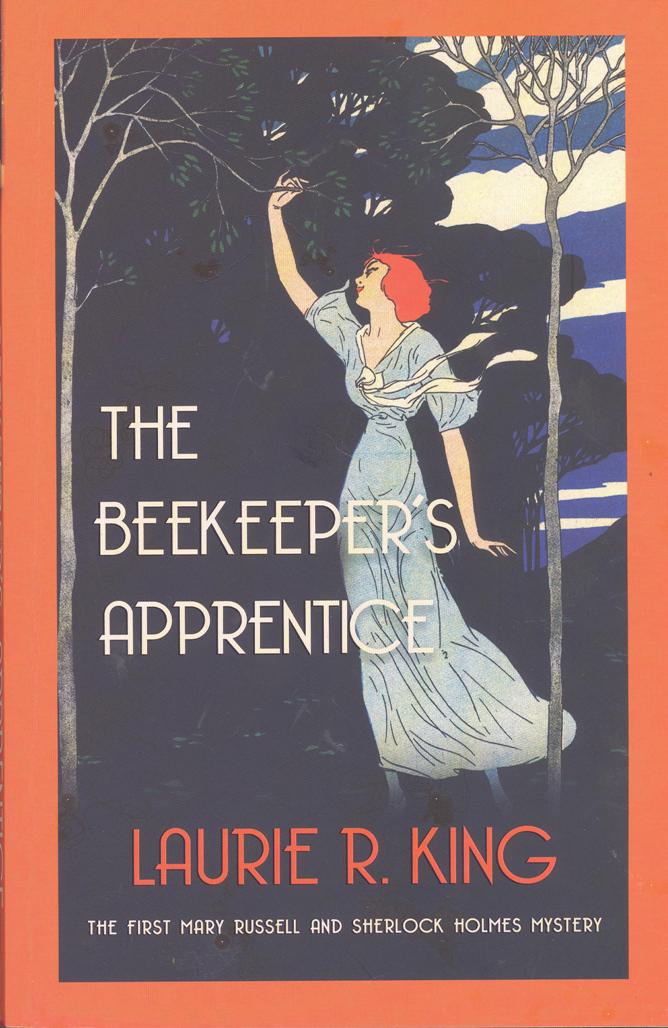
I read this book in May, 2018.
It's always exciting to start reading a new book series - will it be fair, average, good, or excellent ? I then knew little of the author Laurie R King, nor her heroine young Mary Russell, but I had been intrigued by the blurb on the back cover. So it's 1915, the great detective Sherlock Holmes is retired and studying honey bees on the Sussex Downs, when a 15 year old young women literally stumbles into him. Mary Russell is gawky, egotistical, and recently orphaned, but she has a keen intellect, a wit to match his own, and she impresses Sherlock. The book sets up the chance encounter very well. Mary has inherited a farm nearby, but she and her guardian aunt do not get on well, and the aunt seems to be trying to starve Mary into submission. Having mistaken Mary for a young lad, a bemused Sherlock invites Mary back for tea, and faithful Mrs Hudson, still looking after Holmes, feeds the famished lass. Sherlock himself has not been bothering with food, but out of politeness he joins in the meal, gets nourished, and finds a new interest in life that he had never contemplated. They seem to be good for each other. And so begins a great, unlikely friendship, but the exact nature of the friendship is unclear. Partly it's teacher / pupil, partly it's father / daughter, but I detected hints, in spite of their age difference, that something stronger than friendship might even be even be a possibility. But I guess I am jumping ahead wildly.
The Sherlock that we meet is true to Conan Doyle's character, but has been updated somewhat, and has a more rounded, caring gentler character. Yes, he is still governed by fierce logic, but he is comforting too when the occasion calls for compassion and understanding. He is in his early fifties, perhaps younger than we might have expected. This is explained as Watson adding years to Sherlock to add gravitas to his stories. We meet Watson also. Watson is presented as the salt of the earth, and a brave and true friend to Sherlock, but a bit bumbling, and only of average intellect. He was always amazed at Holmes feats of logic, but Mary Russell equals Holmes in intelligence and is less dazzled by the great detective. In one section of the book Watson rushes to an in hiding Holmes, and shaves off his moustache so that he will not be recognised and followed, but he carries his doctor's bag through the streets of London - a dead give away. Mary would never make such a mistake.
The book is split into sections as Mary becomes first apprentice to Holmes, and then enters an internship, and then an associate partnership. Holmes sets puzzles for the young Mary, and each one she solves with distinction. Truly, here is a great intellect. Mary develops into young womanhood almost without Holmes noticing. On a joint mission, Holmes is darkening his new assistant's skin as night time camouflage. "Take off your shirt" says Holmes, and unthinkingly Mary starts to comply when Watson coughs, and Holmes realises what he has said - how inappropriate. It is 1918 after all !
Mary hates her aunt who is stealing from her, but Holmes funds young Mary (with Mrs Hudson keeping a tally ) until Mary comes into her inheritance in adulthood, when every last penny will be repaid with interest. Mary goes to Oxord in 1918, studies theology (as did Laurie King), makes new friends, and even has some fun - using disguise techniques learned from Holmes in a famous prank. But Mary and Holmes are soon reunited.
Initially I started off having doubts about this book when I feared it might just be a collection of short stories lacking in depth. It paints a good picture of the place and time - war time London, but I thought perhaps Jacqueline Winspear's Maisie Dobbs books did it better. But when Mary and Sherlock embark on longer adventures the book improves impressively. Holmes creates a diversion, and Mary has enough self confidence to deviate from the plan, and rescue a kidnapped American senator's very young daughter. Mary has suffered in childhood too, and is later able to comfort the upset little girl in a sisterly sort of way. The brilliant master mind behind the kidnap plot sets out to get revenge on Holmes and Mary, and seems so familiar with Holmes thinking that Holmes is being bettered. Holmes and Mary decide on a tactical retreat and escape the country with help from Mycroft Holmes. Whilst abroad Mary and Sherlock work on a project of national importance. From a list of possible bolt holes, Mary had chosen Palestine. We learn that Mary is a Jew, and she is greatly moved to be able to walk the holy lands. She quotes Hebrew scripture, sings a Hebrew poem that perfectly fits the occasion, and Holmes is struck by his new assistant's hidden depth. Laurie King returns to their adventures in the Holy Land in a later book O Jerusalem < this link won't work until I have read the book !
It's part of Holmes' plan to return to the UK and unmask the master mind, that Holmes and Russell quarrel violently and publicly and say some very harsh, wounding words to each other. In private, Mary is so ill, confused and distraught by the cruel words Sherlock hurls at her, that Holmes secretely slips into her cabin to sit there for a few minutes each night as a comforting presence for Mary. It's becoming deeper than just friendship. Earlier in their exile Holmes and Mary had played chess, and Mary had bested Holmes by sacrificing a White Queen, to mount an overlooked pawn checkmate attack. "You sometime have to sacrifice the Queen to win the game", Mary explains. Holmes goes pale at the alternative explanation of what Mary has said - has Mary to be sacrificed ?
I think I have said enough - it's never my intension to write a spoiler. All in all, a very interesting and promising start to this new series - I hope Laurie King can sustain it.
Links to author index and home page
| Laurie R King Heading | Author Index | Go to Home Page |
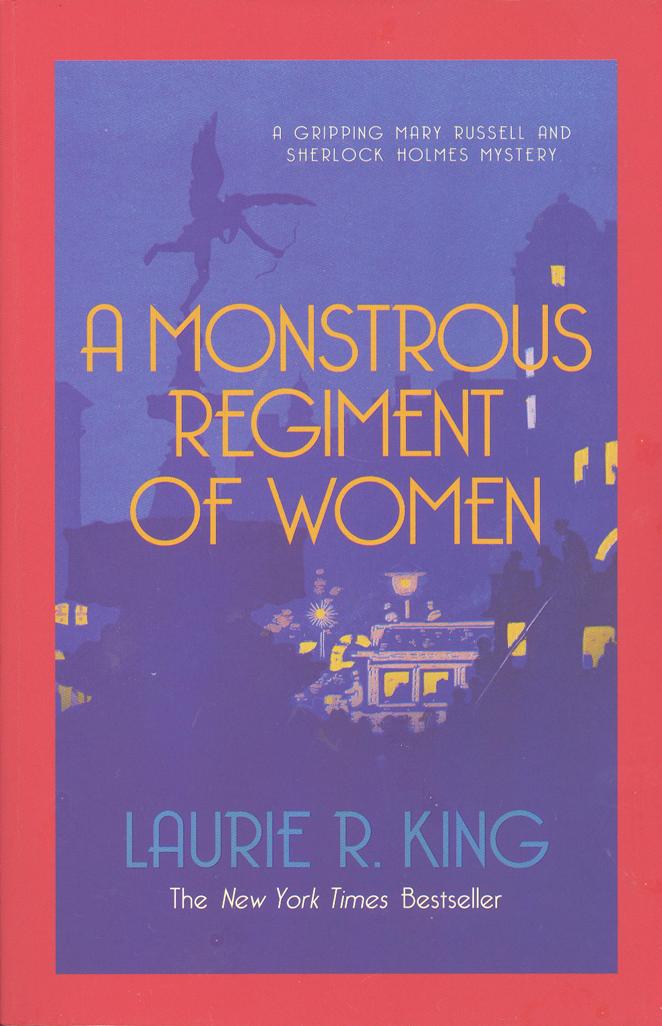
I read this book in Jun, 2018.
This is book two in the Mary Russell meets Sherlock Holmes series. I started reading the series because I was struck by how preposterous the whole set up was. Mary Russell, a wealthy orphan heiresss, 15 years old, wanders the Sussex Downs, and bumps into the great man. She impresses Sherlock, becomes his apprentice, and he teaches all she knows. She is a brilliant pupil, and they tackle cases together. Theirs is s strange relationship - father/ daughter, teacher/ pupil, but already a suggestion of something more.
In book two, Mary is almost 21, and about to come into her inheritance. She is a theology graduate of Oxford. Holmes is 59 - surely too great an age gap for a conventional romance. Russell is disguised as a young lad, and having an adventure in London with Holmes. He could hardly hang around with a young woman - how shocking ! So Mary speculates about marrying Holmes. That would solve their problems at a stroke - and no more problems for Mary when, disguised as a lad, she wanted to "spend a penny". The problem is solved by the end of the book.
The book does have substance. Mary is a Jewish femininst, and she wants to publish her work on the female characteristics of God. Male translators of the orioginal Greek or Hebrew, deliberately got this wrong. She also says "man" meaning mankind, is usually only translated as "man," the male of the species. She translates one passage as a female god writhing in agony to give birth to Eve - a very different translation.
When in London, Mary meets her old chum from her Oxford days, Lady Veronica, and through her she comes across the New Temple Of God, and their suffragette, charismatic and mystic leader, Margery Childe. But Margery lives a life of great opulence, and drinks the finest of wines. She heads a wealthy organisation. It does do undoubted good, educates the poor, feeds the hungry, and provides a shelter for abused women. Mary is impressed by Margery, but wary. She wants to help, and share her feminist ideas. But wealthy benefactors are being killed once they have changed their will in favour of the "New Temple". Is Margery behind this ? How could she not be ?
Mary sets herself up as a potential wealthy donor, is captured, and injected daily with heroin to make her an addict / suicidal. Whilst held captive, Mary works out that her feelings for Sherlock are, strange as it may seem, love. She is in love with Sherlock Holmes ! Holmes is slow in discovering that Mary is missing, but then is distraught. He too has feelings for Mary. Holmes rescues Mary, and knows how best to wean her off heroin.
We also have Lady Veronica being attacked, moved to a safe location, and being cared for by her former fiance.
All in all, a good story, and I don't mind the feminist bible stories - they are kept in the background.
It's all well done, and very readable. Apart from anything else, it's also nice to meet Holmes, Mycroft, and Mrs Hudson once again.
Links to author index and home page
| Laurie R King Heading | Author Index | Go to Home Page |

I read this book in Oct, 2018.
This is book three in the unlikely Mary Russell meets Sherlock Holmes series. It's a series that should not really be as good as it is - it's based on a preposterous idea that a gifted young American orphan girl chances upon a "retired" Sherlock Holmes on the Sussex Downs, impresses him with her spirit and intellect, becomes his pupil, then goes off to Oxford, then becomes his detective partner, and finally his wife. The Holmes of these books is the same Holmes, but has softened and is no longer driven only by logic. They have both genuinely fallen in love, in spite of their age difference, and there are lots of touching scenes where each longs for each other's company and wants only to please the other. None of Holmes's powers has dimmed, but now we have two formidable brains tackling each problem. And Mary Russell is her own person - a strong willed, feminist, Jewish biblical scholar. As I said, it's a strange combination, but all credit to the author, somehow it works.
As well as Holmes himself we have Holmes's brother Mycroft, Mrs Hudson, a grown up Billy (the young lad who spied for Sherlock), an inspector Lestrade of Scotland Yard, but sadly in this book, only background references to the good Dr Watson.
It's a very interesting story that held my interest throughout. Holmes and Russell are visited by Dorothy Ruskin, an old friend of Mary's. Dorothy is archeologist just returned from Palestine. She leaves in their care an ancient papyrus manuscript that astonishingly might be an epistle from Mary Magdalene. It suggests that Mary was an apostle - the possibility of a female apostle would have stirred up such a storm in the 1920's. It would still be quite spectacular today. This side of the story is left in the background following the murder of Dorothy Ruskin by a hit and run driver. Sherlock had been getting somewhat bored, and jumped at the chance to investigate this crime, and Mary Russell too relished another detective outing. In the days before her death, Dorothy had visited her sister Erica Rogers, and a retired Colonel Edwards whose committeee might finance a Palestinian dig. Had she said anything to them that might have lead to her death ? Dorothy's lodgings had been ransacked, and in their absence Holmes and Russell' cottage is later also ransacked. Is someone searching for the ancient papyrus ? Mary Russell goes undercover to investigate Colonel Rogers, and a suitably disguised Holmes tackles Erica Rogers.
There is quite a bit of humour in these stories. The conversations between Sherlock and Mary often sparkle, and I liked a section where a "Bertie Wooster" type friend of Mary's kept two chums of Mary's out of the way lest they recognise the undercover Mary Russell, and give the game away. Dr Watson has made Sherlock Holmes famous, and Erica Rogers who takes "The Strand" magazine is a fan. Chief Inspector Lestrade is the son of Conan Doyle's Inspector Lestrade. He tells Sherlock how his father enthralled him with stories about the famous Sherlock Holmes. Holmes pioneered so many techniques (eg fingerprints) now standard police procedure in the 1920s. The author Laurie King paints a very plausible picture of a Sherlock Holmes still active all these years later. In short, it's all done so well.
At the end, when it seems our duo may have failed, a chance remark by Mary ignites a new line of enquiry, all ends well and successfully, and Mary and Sherlock return to domestic bliss - Mary to her studies, Holmes to his bee keeping.
Links to author index and home page
| Laurie R King Heading | Author Index | Go to Home Page |
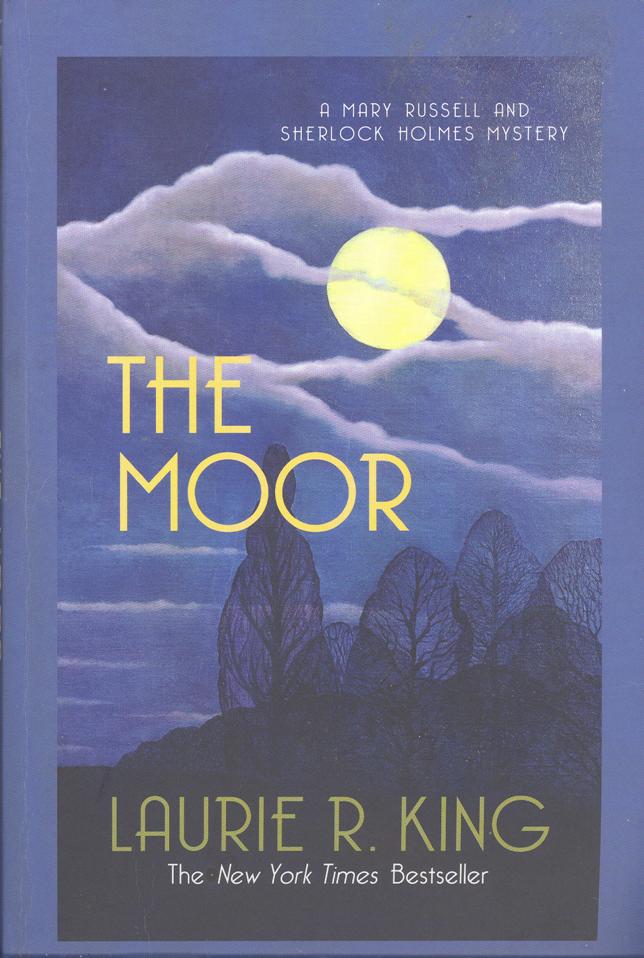
I read this book in Nov, 2018.
This is book four in an unlikely combination of a young heiress Mary Russell meets an older Sherlock Holmes series that I really like. It's a preposterous idea that should not work, but it's done so well, the author has re-created a Sherlock Holmes that is really believable - so somehow I have become hooked. Of course, Sherlock Holmes is an interesting character, but Mary Russell, a young Jewess, a serious biblical / Hebrew scholar, more than holds her own. Now she is Mrs Holmes, but prefers to be addressed as plain Mary Russell. The partnership is Holmes and Russell, and both often go their own ways, but there is a genuine mutual affection that is understated, but handled very well. In short, in their own way, they are devoted to each other.
This book is set in wild Dartmoor - the "Moor" of the title. The moor is almost a character in the book - a beautiful, ferocious, unforgiving wilderness whose bogs can swallow you hole, and your body will seldom be found again. The main character of this story is Reverend Sabine Baring-Gould, someone whom Sherlock calls a friend. Mary comments that the only other person that Holmes calls a friend is Dr Watson - now too old for these adventures. Gould knows Dartmoor better even than Holmes knows London, and he helped Sherlock when Holmes tackled the The Hound of the Baskervilles. Now there is another strange creature lurking on the moor - a phantom coach pulled by the skeleton bones of some horse, and another wild dog. Sometimes the dog is seen by itself, sometimes with the coach. The people of the moor either live on the wilds of Dartmoor, or in villages, and seem two separate tribes. The "moor"ones are strong, enduring, the salt of the earth, but superstitious. Mary gains their trust.
The story opens with Mary researching away in Oxford when she gets a message from Holmes to drop everything, and meet him in Dartmoor. She puts the message aside, but gets another half an hour later saying "put down your books, and rush down to Dartmoor at once". How well Holmes knows Russell ! She arrives at night in a deserted Coryton railway station to find a note from Holmes pinned to a wall. She has to take the north path to join him and Gould in Gould's mansion "Lew House". It's a poor, muddy, treacherous path and the wind and torrential rain pound down on poor Mary. Covered in mud and soaking wet, she eventually struggles to Lew House and a very dismissive greeting from Gould - "were we waiting for that ?" Mrs Elliot, the housekeeper is temporarily away, and so the radiators do not work, there is no hot water, and supper is only slightly edible. Mary wants to go back to Oxford, but Holmes tells her he needs her help - so of course she must stay.
It's a bit of a mystery to Mary why Holmes defers so much to old Baring-Gould. But eventually we and Mary find out, and with Mrs Gould back the heating now works, and the home cooking is excellent. Mary even grows to like Gould.
Two neighbours visit Gould - a rich American Richard Ketteridge, and his secretary David Scheiman. Holmes and Mary are invited to join them for dinner at their house. Baring-Gould does not tell them that Ketteridge has bought Baskeville Hall. Had he known Holmes would not have accepted the invitation. I should mention one other sub plot - the army are testing a new secret tank on the moor, but the secret has been broken, and brother Mycroft has asked Holmes to investigate whilst in the area.
The story now unfolds in it's own good time, with lots of atmosphere, and wonderful descriptions of the "Moor" in all it's moods. I didn't mind the lack of action in the slightest - Laurie King is a good writer, and we are in good company with her characters Holmes and Russell. Eventually the story heats up, there is adventure aplenty, and it all comes to a satisfying conclusion. All in all, a really good story.
Links to author index and home page
| Laurie R King Heading | Author Index | Go to Home Page |
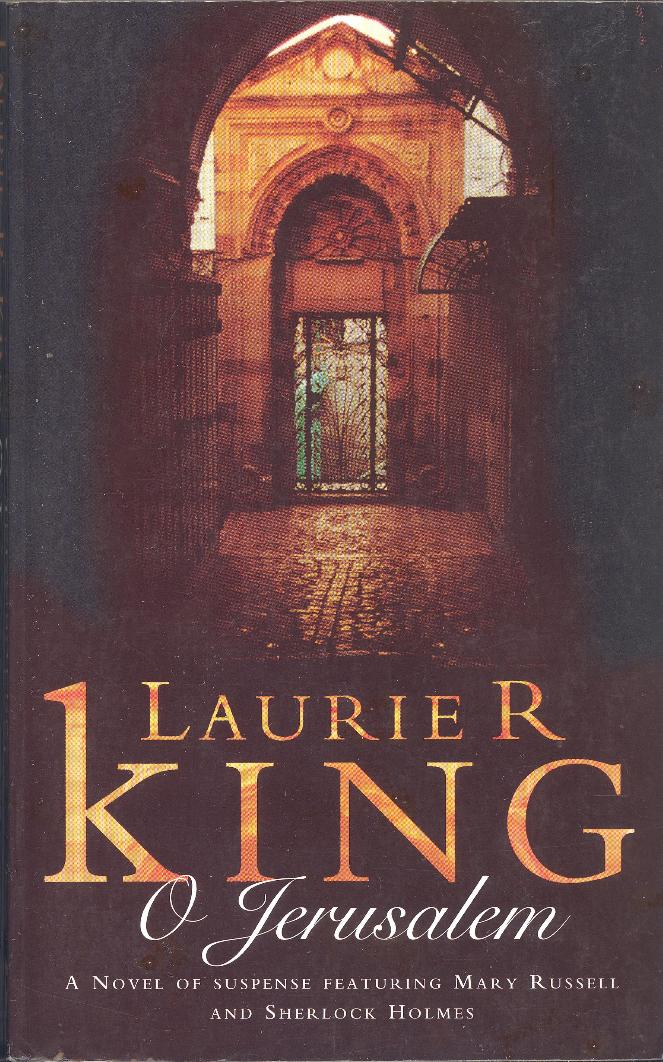
I read this book in Dec, 2018.
This is book five in what is turning out to be an excellent series. It's the ongoing adventures of Mary Russell, a young American heiress and her partner and now husband, the great Sherlock Holmes. They met by chance on the Sussex Downs, she became his student, then partner, and then wife. It all sounds preposterous, but somehow it works because of some fine writing. Laurie King has captured the spirit of Sherlock Holmes - I always felt I was reading about the same Holmes character as created by Conon Doyle. There are all sorts of other dimensions to these books. The author is an American Jewess, and her creation Mary Russell is also a Jew, and a fine Hebrew scholar. This book tells of the adventure that befell Sherlock and Mary when they had to escape from England - ie those referred to in book one. Chronologically, this should really be book 2, but the author chose not to be diverted in telling the personal lives story of Holmes and Russell. In book 4 they are husband and wife, and there is no doubt that they are in love. Now in book 5 we jump back to 1918, when Mary was still Holmes's student / assistant, and romance lay in the future.
Homes and Russell had to escape England to regroup, and sought help from Mycroft, Holmes's brother. He offered them five possibilities, and Mary jumped at the one that entailed a visit to Palestine. What Jew would not want to visit the Holy Land. Eventually this adventure takes Holmes and Russell to Jerusalem. Mary just wants to sit on a hill and worship the place, and as a Jewish scholar knows so much about the history of the place. Most readers will recognise lots of places that are mentioned in the Bible. Mary certainly does - she in not a christian, but Jews and Christians have a shared history. The place is also holy to Moslems. The author helpfully gives us a summary of the history of Palestine. This story is set in 1918, and General Allenby has driven the Turks out of the Holy Lands. The place is now administered and ruled by Britain (think of the times of Empire) but we now think of the place as a poisoned chalice. Old enemies still fight old enemies 100 years later - but Allenby seemed a decent honourable man.
In reading the story I was reminded of the adventures of John Buchan's boys hero Richard Hannay. It's that sort of yarn - adventure on a grand scale, Empire, politics, espionage, intrigue, for "King and Country, " etc. When Holmes and Russell land secretly in Palestine, they are met by two Arab contacts - Ali and Mahoud. The arabs don't trust this strange pair - an old man and a young girl, and lead them in circles, cold, hungry and exhausted. Mary wonders why she is there. She would prefer to be back in Oxford with her books. Holmes recognises that they are being tested - a test that they pass. Initially the problem they have been sent to help with is introduced as a series of unrelated murders throughout the country, but Holmes thinks that these and the anti government rumours are connected and being orchestrated. Not all the Turks have fled - some are lying low to strike at Britain in a terrorist movement. It seems there may be a spy in Allenby's HQ, and the car carrying Holmes, Russell, Ali and Mahoud is ambushed and Holmes is captured and tortured. Mary, Ali, and Mahoud have to rescue Holmes, and save Jerusalem - so it's adventure on a grand scale, well told by a gifted author. It all builds to a succession of climaxes, and certainly kept me turning pages.
I liked the story, and the history lesson. I don't think I have ever read a better description of what it's like to visit an Arab Souk. And throughout the fledging Holmes and Russell relationship is handled perfectly. It's a perfect capture of place and time - poverty and squalor. Well done, Laurie King.
Links to author index and home page
| Laurie R King Heading | Author Index | Go to Home Page |
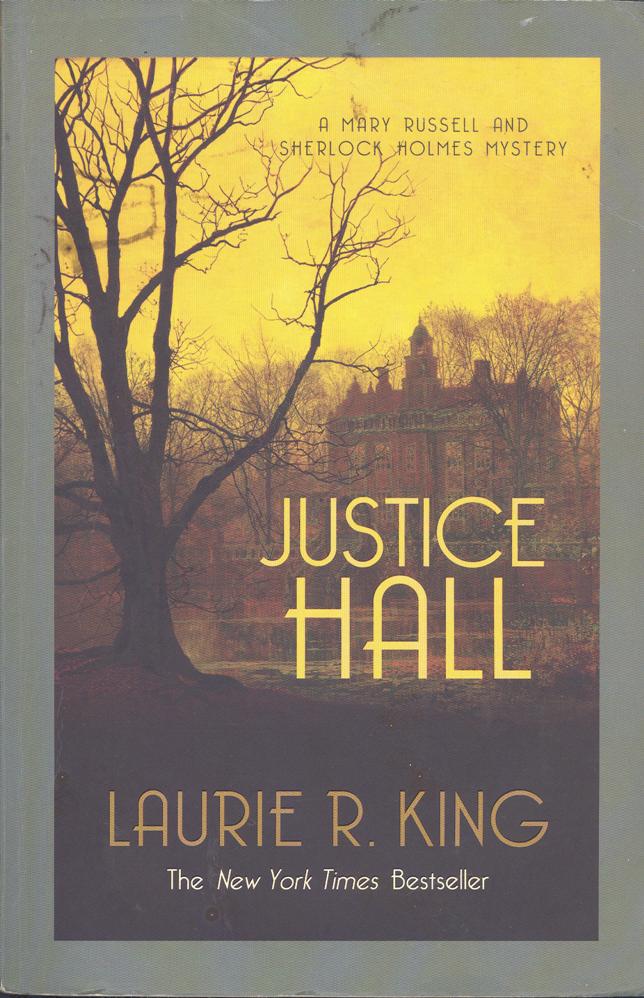
I read this book in May, 2019.
This is book six in an excellent series that should not work - Sherlock Holmes in "retirement" meets a young American orphan, befriends her, takes her as a pupil, then apprentice, then a business partner, and then wife. Mary Russell and Sherlock Holmes ! It works because the author is a good writer, is always true to Sherlock Holmes / Connon Doyle, has done a tremendous amount to research - she is a Jewish, feminist, academic - and captures the place and times perfectly. Here we are in 1923, in Justice Hall, a fabulous tudor and earlier country seat of a Duke of England.
I think it helps to have read "The Moor" , book four of the series, and to know who Mahmoud and Ali are, but the book works without knowing this. Sherlock and Mary have returned home after a successful, but tiring adventure, and are being fussed over by Mrs Hudson. Watson is only mentioned once - he is on holiday in Egypt. It is bed time, but there is a knock at the door. It is Ali, injured and asking Mary and Sherlock for help. Holmes, Ali, Mahmoud and Mary were in constant danger together in the Arabian desert, and saved each others lives. This forged a tie of brotherhood. Of course, help must be given, no question.
Ali explains that before he went to Arabia, he was an English gentleman - Alistair Hughenfort, and his cousin Mahmoud likewise is Marsh, Duke of Beauville, and master of Justice Hall. Marsh / Mahmoud had to return to England to do his family duty with centuries of history on his shoulders. It is destroying him. Mahmoud and Ali really belong in Arabia. Ali asks Holmes and Mary to help their brother Mahmoud. No one is sure what the story will be - what case is Sherlock being called upon to solve ? But he will dig, find a stray thread, and see where it leads. Can another heir to Justice Hall be found, freeing Mahmoud, or is there no such person ?
As readers, we likewise are not sure what the story will be for about half the book. We do get a detailed and astonishing tour of Justice Hall. And then we set out to find how young Gabriel Hughenfort came to be shot in war time France, not for cowardice, but for refusing to obey a stupid order that would have lead ten of his men to their certain death. The motto of the Hughenforts is "Justitia fortitudo mea est" -"rightousness is my strength" (or "do the right thing"). Young Gabriel did what he thought was right, and got shot by a firing quad.
There are pages and pages of descriptions of the hell that was WW1. I was reminded of some of similar sections in Jacqueline Winspear's Maisie Dobbs Books . I sort of worked out where the story was heading in it's final quarter.. I would have been so disappointed if I had been wrong, but I wasn't. I think here a "happy ending" was wholly appropriate, but only after a lot of tension and horror.
It's a good story - sustained brilliance from Laurie King. Mary Russell and Sherlock Holmes are wholly believable. A "tour de force." Where to next, I wonder ?
Links to author index and home page
| Laurie R King Heading | Author Index | Go to Home Page |
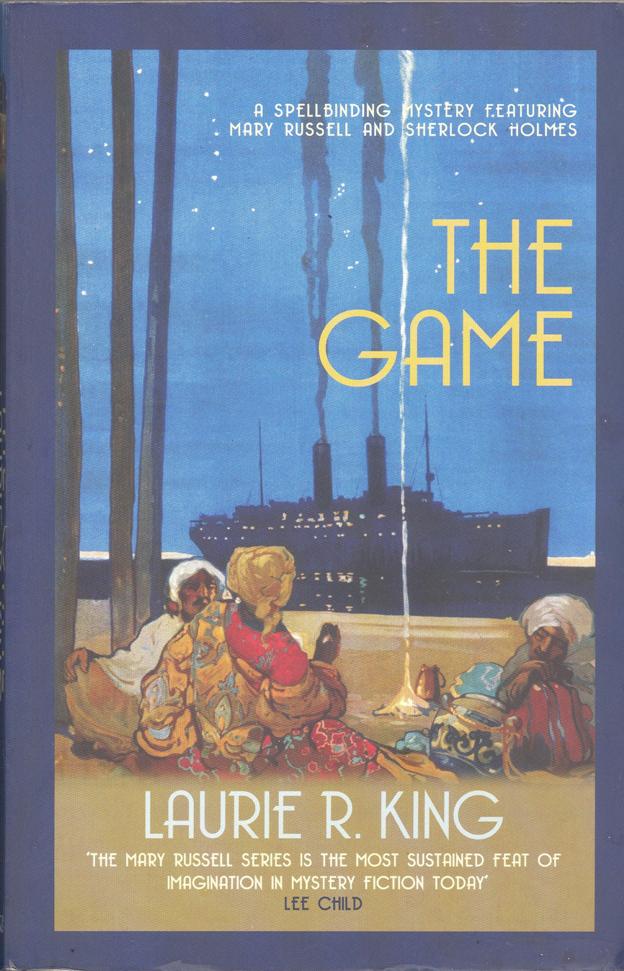
I read this book in September, 2019.
This is book seven in the Mary Russell meets Sherlock Holmes series, and it's set in 1924, in the days of British Empire. It's a very clever book based obviously on such a lot of research - sources are acknowledged at the end of the book, and include Lord Baden Powell on pig or hog sticking - fighting wild bore on horseback with only a sharpened wooden stake. Mary is to be thrown in at the deep end with pig sticking. It's a clever book in three ways. Firstly it's an adventure yarn, secondly it's historical fiction set in the India of the 1920s, in the princedom of Khanpur, where place and period are depicted brilliantly, and thirdly it's based on two very strong main characters, the feminist Jewess orphan Mary Russell, and her husband, a very convincing (for me) recreation of the great Sherlock Holmes. Story, period and place, and great characters - tick, tick, tick !
The story opens gently with Mary and Sherlock back in their Sussex Downs home for a period of rest and recuperation when they learn that Sherlock's brother Mycroft, of the secret service, is seriously ill. They rush to visit him, and are persuaded to give him a helping hand. One of his agents has been missing for a couple of years, but it's a special agent Kim (Kimberley O'Hara) about whose childhood Rudyard Kipling wrote. Now grown to manhood, Kim is a spy (spying - the Great Game of the title), but is he dead, captured or is he now working for someone else ? Mary and Sherlock agree to go to India to make enquiries. On the liner on the trip there, they meet an American family - the Goodhearts - and Mary makes friends with the beautiful but child like Sunny Goodheart. Her brother is Thomas, apparently an American marxist. The Goodhearts are going to visit a friend of Thomas's - "Jimmy", the maharajah of Khanpur. This character is fabulously wealthy, an autocratic, ruler of his princedom, but cruel, and in the end a madman.
There is a useful map in the book showing the various regions of India in the 1920s. Most are fully British ruled, but some still have the ancient feudal princes who are allowed some overlord role, and such a place is Khanpur, near the border with Afganistan.
The British repersentitive in India is called Nesbit and he explains that he fears there may be a spy in his department. Therefore, it's in complete secrecy that Mary and Sherlock set out, disguised as itinerant magicians, working for a few rupees in native villages as they travel the remote countryside. They think Khanpur holds the key to the missing Kim, and enroute there, Mary and Sherlock go their separate ways, Mary joining the Goodhearts party and getting herself invited to visit the maharajah, and Sherlock continuing across country as a magician. He has acquired a donkey and cart from a young lad, Bindi, who tags along and attaches himself to the venture. What Bindi's role will be is unclear, but it turns out Bindi is rather special.
No one is as they seem. There are now a series of daring adventures , page after page of them, when danger strikes, and all seems lost, but somehow our heros survive.
The Maharajah has a private zoo of exotic animals, but he also collects people, paying them to undertake various projects but making it difficult for them to ever complete them and leave. Jimmy wants to capture Mary Russell, but she escapes before she can be trapped, and then returns as her "twin brother " with false moustache and cropped hair. The maharajah is indeed up to no good, intent on insurrection / possibly plotting to help Russia to invade India. Mary as her "twin brother", and the disguised magician Sherlock escape Khanpur again. They then decide they must return and capture the maharajah - if they call in the army there will be a bloodbath, casualties, and a terrible loss of innocent lives.
The adventure story reminded me of childhood days at the cinema when a film serial was on the programme. The hero would be trapped in hopeless situations with no escape possible, but at the opening of the next episode "with one bound he was free" and escaped. Here this is repeated over and over again. It's all completely implausible , but never mind, just go with the flow, and enjoy the escapist yarn. It's all done very well . Laurie King has somehow captured the essence of the Sherlock Holmes character , and placed him in very different settings, but to me it somehow seems the same Sherlock Holmes. How does she do that so well ?
Laurie King also paints an equally vivid picture of both sides of 1920s India. The maharajah is desperately wealthy, but bored with no role in life and very resentful of the British interlopers telling him what to do when his is a centuries old proud lineage. And the common people are desperately poor struggling to exist and scrape a living in dirty hovels.
It's a lovely, different series, and a great example of historical fiction. What next, I wonder ?
Links to author index and home page
| Laurie R King Heading | Author Index | Go to Home Page |
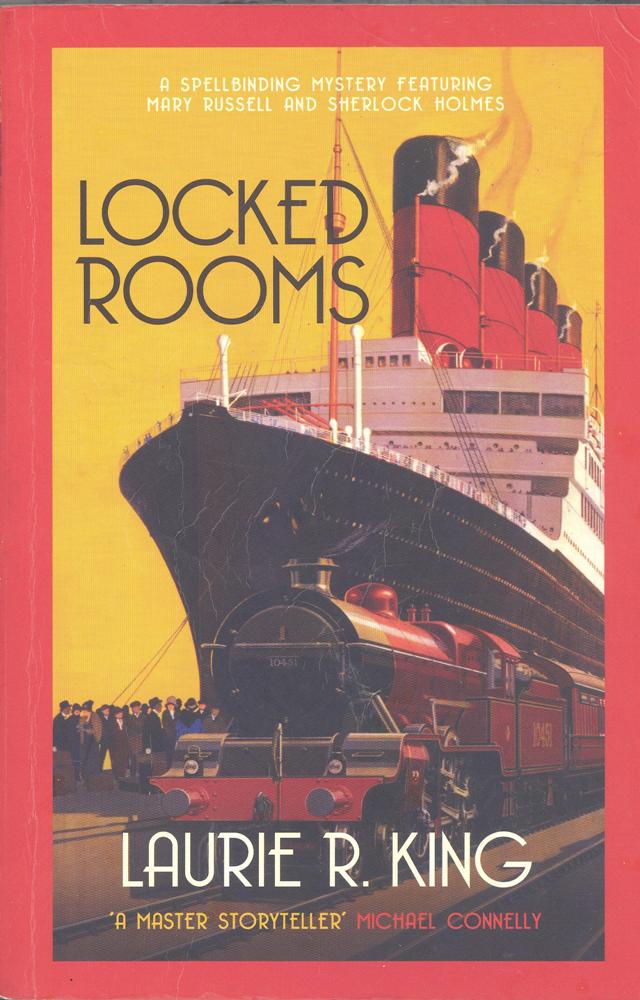
I read this book in October, 2019.
" The Most Sustained Feat of Imagination in Mystery Fiction Today " - Lee Child.
This is book 8 in a delightful series where a Jewess, orphan, heiress Mary Russell has married the famous Sherlock Holmes . The recreation of Sherlock is spot on at all times.
I usually have several book series on the go at any one time. I read a book from one series, then a book from another series, etc. This way, "not so good" series are well spaced out, and really good series resurface again as almost forgotten treats. However, I really should read this Mary Russel series more frequently. It's a really good depiction of character, time (1920s), and place. Laurie King is a gifted writer, and should be better known.
We met Mary Russell in book one - 15 years old, orphan of a tragic accident. She was 14, in the back of her mum and dad's car, arguing with her brother, her father was distracted, the car swerved off the road, Mary was flung free, but the rest of her family plunged off the cliff to their deaths. Mary blamed herself for the accident, and for surviving. She told her stoy to only two people - a lady psychiatrist doctor who was helping child Mary, and years later her husband Sherlock. Sherlock had doubts about the accident but kept them to himself. Mary, it seems, tucked away all memory of her childhood in a "Locked Room" in her mind. Now it is all about to untangle.
We first join Mary and Sherlock on an ocean liner en route from the far east to San Francisco. Instead of returning directly to England, they are stopping off in California to wind down her parents' estate - ownerships of multiple factories and varied properties. Mary is a very, very wealthy heiress. As they head towards San Francisco, Mary is plagued by three repetitive nightmares. Things are being flung at her in one, in another she is with a faceless man in a bright room with no windows, and in the third nightmare she keeps walking past a door to a hidden room that takes many shapes. She knows she can enter this room at any time , but she always choses not to. Mary cannot sleep, has lost her appetite, is thin and weak, is wasting away before his eyes, and Sherlock is very concerned. His wife is not thinking properly, her intellect seems to have collapsed and failed !
The story unfolds in four parts, told first by Mary, then by Sherlock, then by Mary, and then by Sherlock again.
In San Francisco, Mary is shot at in chinatown, and discovers that just about everyone who knew her mum and dad had died a mysterious death - the psychiatrist who treated Mary, her mum and dad's two chinese servants, etc. There is a real mystery to be solved, and who better to solve mysteries than Sherlock Holmes ?
Sherlock is keeping a watchful but secret eye on Mary when he observes that he is being followed by a skilled PI - but one with TB and a bad cough. And so Sherlock and we met Mr Dashiel Hammett - a writer of crime fiction, ex of the Pinkertons, and a man whose word is his bond. (Memo to self - I must read some Dashiel Hammett). Hammett is not too happy with his present asignment following Sherlock, and so, after much agonising, he switches sides to help Mr Holmes. Quite a combination !
The fourth member of the team is Tom Long - the book shop owner son of the Russell family Chinese servants. Something foreign or malign may be hidden / buried in the overgrown garden of Mary's parent's family home, which the Chinese servants tried to counter by Feng Shui techniques to try to restore garden harmony. Tom Long calls in a Mr Deng - a revered Feng Shui professor to work back from the changes done to the garden through the years to discover where the "bad" element might be hidden.
I was intrigued by some of the Feng Shui discussion - the lines of good fortune can sometimes be mistaken for the lines of Feng Shui (cf ley lines), and by altering Feng Shui order, so good fortune can be influenced. As Mr Deng explains, no one nowadays believes that there are dragons underground which have to be appeased - but we use an old methaphor to write and talk of such intangible concepts.
Mary was there as a child in the earthquake and great fires that shook San Francisco in 1906 - but she had locked this memory away with so much else of her childhood.
Mary meets Flo, her best friend when they were both six. Flo now has a boy friend Donny who loves her, but Flo will not say yes to marriage, and of course Donny an Flo are not sleeping together. Flo and Donny laugh at their parents old gramaphone records and how old fashioned their parent's generation now seems. But "now" is 1925, and Donny and Flo now seem old fashioned to us. And so it will always be?
Mary, Sherlock, Tom Long and Dashiel Hammett, and some street urchins recruited by Sherlock win through in the end. Mary starts to eat again, and to sleep soundly and rest, and her old self is returning. All in all, a fascinating story, with even mentions and bit parts for Mycroft and Dr Watson. A true 5 star story.
Links to author index and home page
| Laurie R King Heading | Author Index | Go to Home Page |
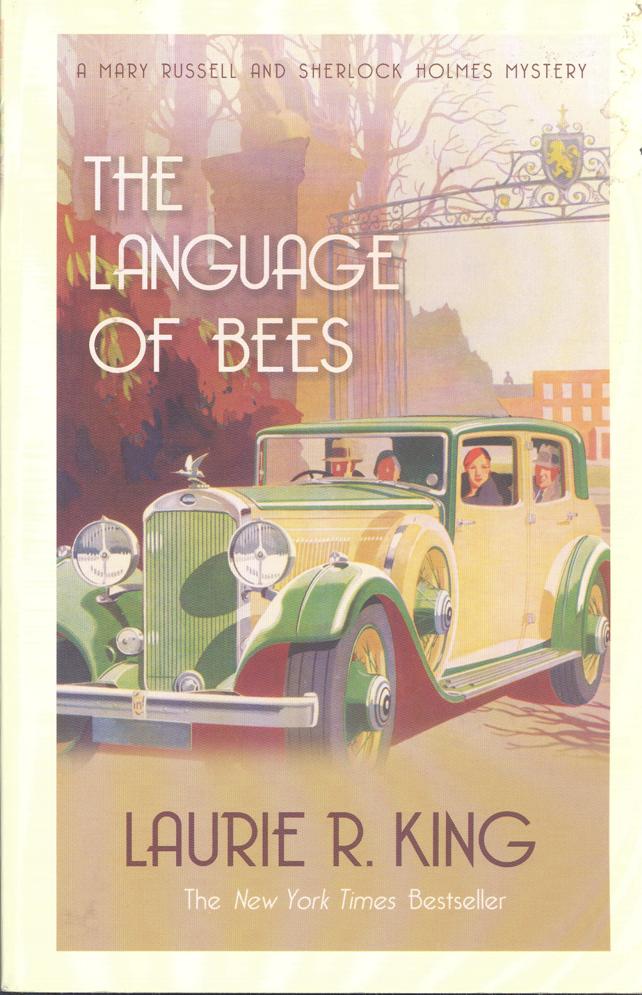
I read this book in January, 2020.
This Mary Russell / Sherlock Holmes series is usually very good. I have accepted the main premise that an orphan American heiress as a young girl mets the "retired" Sherlock in his Sussex countryside home, and they become friends, partners and eventually get married. Now however we have what I initially thought was a step too far - a son for Sherlock. Apparently Sherlock met Irene Adler again - she had effortlessly outwitted him earlier in his career. She was down on her luck, he helped her, they became lovers, and a son was conceived. However Irene again outwitted Sherlock. He never knew of his son. Irene told Mycroft in case anything happened to her, but Mycroft was sworn to secrecy. Eventually Sherlock and Mary were told, and Sherlock met his son, Damian Adler. Damian resented the father whom he thought had abandoned him . "I never knew" protested Sherlock. "You should have known" said Damian. Damian went away to Shanghai, and wanted nothing to do with Sherlock. Earlier on Damian had served in the French army, was a decorated officer, was wounded, was treated with powerful drugs, and so sadly began his drug addiction. Damian however is a gifted artist, well known and successful in the surrealism genre.
This book opens with Sherlock and Mary returning home after global adventures to find Damian waiting for them there - their first contact in over five years. Damian needs his father's help - he also gets Mary's. In Shanghai he married Yolanda, a former child prostitute. They had a daughter Estelle - she is about three and a half years old now. Yolanda and Estelle are missing - and Damian is desperate to find them.
Mycroft appears a lot in this story - doing all he can to help Sherlock. Yolanda had got herself caught up in an extreme fanatic religious cult - a mumbo jumbo of belief in light, the moon sacrifices, the Book, the "Master" prophet, etc, etc. We get far too much about the cult's beliefs - the author is a theology student, as is Mary Russell - and here we are dealing with the black mass.
Eventually Yolanda is found dead - she had been sacrificed at full moon at the foot of an ancient Stonehenge type monument. It is obvious that Damian has been concealing so much of his story from Sherlock. Is he mad ? Did he kill his wife ? Later the question is did Damian help the "Master" in these sacrifices.
The police - Inspector Lestrange, son of the Inspector Lestrange - want to question Sherlock and Mary, but are fobbed off by Mycroft. Later in the book there is a suggestion that Lestrange has raided Mycroft's house. Would Lestrange dare to attack someone at the head of what we now call MI5, MI6 ?
It all builds up to a terrific climax in Orkney. Mary rushes there to save little Estelle in a very dangerous aeroplane flight in the early days of aviation. The ex war fighter pilot is daring to the point of madness, but a brilliant flyer. They are battled by storms, troubled with dirty petrol, and sort of crash land several times. Mary hates the experience, and vows never again, but remembers Estelle, and goes back into the plane.
And then the book has the worst possible ending - three little words "to be continued". I felt cheated !
Links to author index and home page
| Laurie R King Heading | Author Index | Go to Home Page |
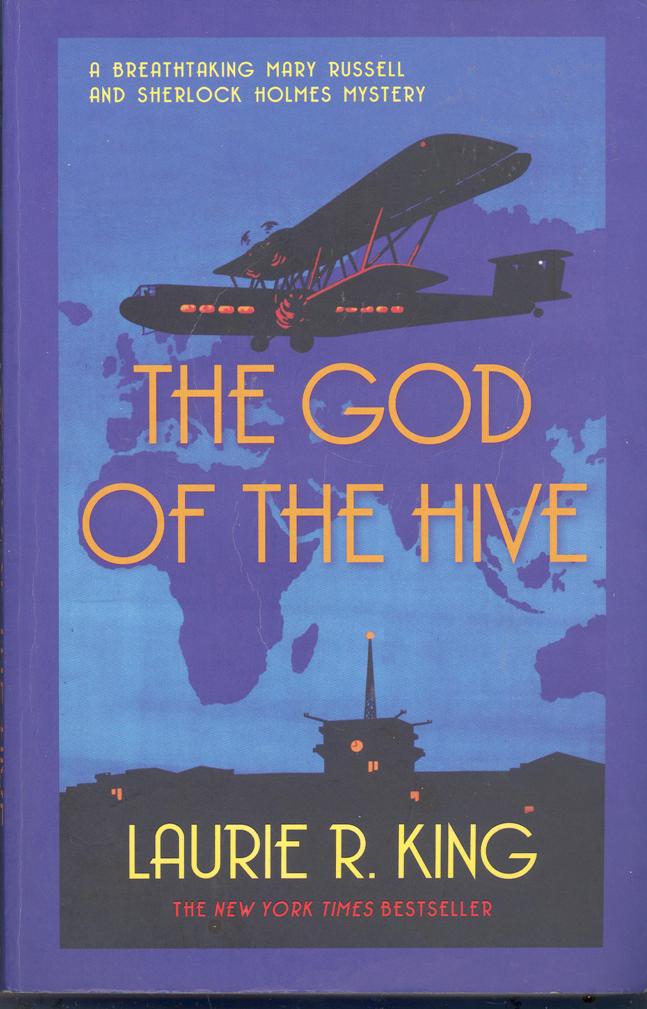
I read this book in February, 2020.
This is book 10 of the Mary Russell /Sherlock Holmes series. I read book 9 on holiday in Australia, and was annoyed to find that it was part one of a two book story. It ended with "....to be continued." Then by pure luck, I found this book, part 2 of the story, in an "Op shop" (charity shop) whilst stilll on holiday in Australia, and so was able to complete reading the story.
Book 9 introduced the son that Sherlock's didn't know about , and Sherlock's granddaughter Estelle. The son, Damian Holmes, had turned up in Sussex to ask for his father's help. Help was readily given by Mary and Sherlock. It's a story about a religious cult leader who killed Damian's wife, threatened to kill Damian, and kidnapped 3 year old Estelle.
Now the story continues. Sherlock and Mary part. Sherlock goes by boat from Orkney to Holland (via Wick) with Damian, his wounded (gun shot) son, sort of kidnapping Dr Henney en route in Wick. Henney skilfully removes the bullet from Damian's shoulder on a stormy sea, and she and Damian get on well. It seems she and Damian may eventually settle down together.
Mary has equally hair raising adventures getting Estelle away from Orkney with her American pilot in an aero plane. Like Holmes, someone is hunting them - someone with vast resources. The plane is shot at, the cockpit is shattered, Estelle is terrified, the plane crashes into a wood, and a strange "Green man" comes to rescue them. Let's call him by his second name, Robert Goodman. He is a brilliant split personality man, sadly quite insane. In his former life he was a British officer who buckled under the demands of leadership - having to get his men to do impossible things on risk of death, and to what gain. In his new personality he stole an ambulance, and rescued countless injured British and French soldiers - he was awarded the Croix de Guerre. Both he and the American pilot are champion defenders of little Estelle. Robert Goodman is the spirit of the woods, but is not of this life. He happily gives his life in the service of little Estelle. It's very well told, and completely understandable. Great story telling.
It now turns out that the real story behind books 9 and 10 is that there is an enemy of Mycroft Holmes who is jealous of the power he holds and exercises. He covets this power and wants to use it to move the country in a different political direction. The enemy is Peter James West, ex SIS - a clever young man of great ambition. Yes, Mycroft really was arrested by Chief Inspector Lestrade - but on higher orders. Mycroft was released almost immediately by the police, but grabbed by West's thugs, and drugged. Then Mycroft's obituary appears in the papers. Although it's an obvious trap, Sherlock and Mary attend Mycroft's burial - one where the surprise music is provided by Robert Goodman. Who are real mourners, who are police, who are thugs, who are allies suplied by Sherlocks friend and helper, Billy ?
Is Mycroft really dead ? What do you think ?
It's a great well told story, full suspense and terrific characters. Will the brothers Holmes and Mary outwit West ? More worryingly, did West have unknown helpers, who survive and may strike again ? A huge story, and a great read.
Links to author index and home page
| Laurie R King Heading | Author Index | Go to Home Page |
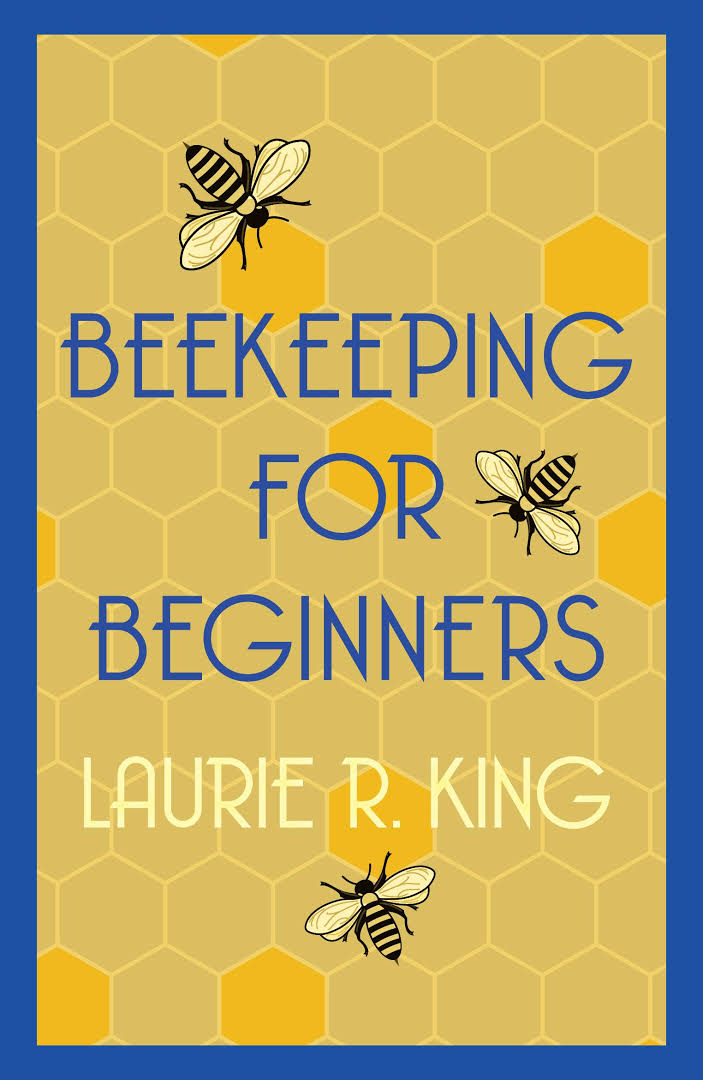
I read this book in March, 2020.
This is an interesting member of Laurie King's Mary Russell / Sherlock Holmes series in that it is a novella of only 52 pages, say about one fifth the size of a normal book. It was first issued an e-book, but happily I found a printed version at the end of book 13 - "Garment of Shadows." I copied the picture shown along side from the internet.
At the very beginning of book one, "The Beekeeper's Apprentice" we were introduced to the young Mary Russell, an American orphan heiress being looked after (very poorly) by an aunt, and living on the Sussex Downs. We then hear how she meets a "retired" Sherlock Holmes who is doing an experiment with paint and bees, greatly impresses Sherlock, and eventully becomes his apprentice. We hear all this from Mary's point of view. Now Laurie King cleverly retells the story from Sherlock's point of view, adding quite a bit to the tale.
The extra detail reveals two things that Mary never knew - Mary more or less saved Sherlock's life, and he went on to save hers. Apart from one or two adventures, Sherlock really was trying retirement, but it didn't really agree with him. His great mind lacked stimulus, and he was sort of wearying of his present life, and contemplating suicide, although he had not yet made up his mind. Meeting Mary jolted Sherlock back into a purposeful life. Sherlock learned of Mary's history - she was a very wealthy heiress. He also took note when a series of mishaps befell the young Mary. Usually in the soundest of health she had sudden illnesses, fell down stairs, etc, etc. Mary's life with her aunt was not a happy one. The aunt was stealing from Mary's inheritance, and she and her son, Mary's cousin, were uncaring and cruel. Sherlock had asked Mary if she had made a will. "Yes, I have", replied Mary, "and my aunt and cousin get nothing". But some of Mary's papers were lost at sea, and the will had to be redrawn. Sherlock correctly suspected that Mary's aunt or cousin were trying to kill her before they could be cut out of the inheritance. And so, at the end of this story, we have Sherlock protecting Mary, and saving her life when her cousin acts against her - but Sherlock is careful to keep secret both the attempt on Mary's life and his part in saving her. He doesn't want young Mary to lose her charming youthful innocence.
The book is full of beekeeping advice, as Sherlock introduces Mary to the wonder and joys of the hive. He sets out various rules for beekeeping, with rule three the prime one "Never, ever, cease to feel wonder."
Links to author index and home page
| Laurie R King Heading | Author Index | Go to Home Page |
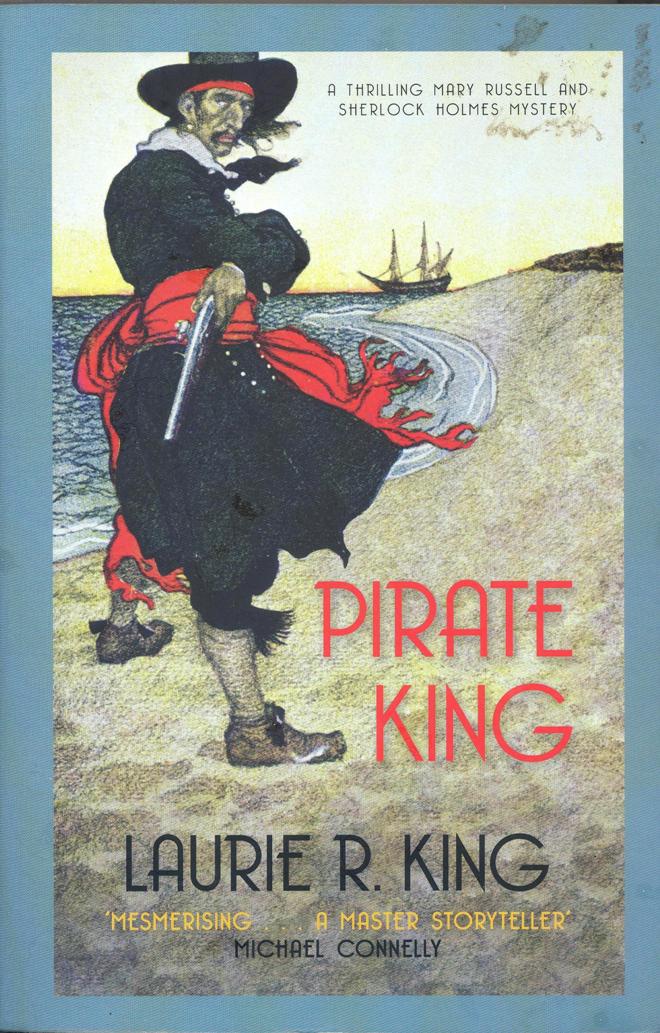
I read this book in September, 2021.
This is book 12 in a series I surprised myself by liking, but sadly I didn't care much for this particular adventure - a switch to farce and comedy that was OK in parts, but didn't really work for me. I thought it was a lot of rubbish at times, and Mary's husband Holmes, after a brief appearance in the opening, doesn't reappear until page 198. It is allegedly based on Gilbert and Sullivan's "Pirates of Penzance" opera - see footnote for the G & S plot. Flytte Films are making a film about making a film of "The Pirates of Penzance", but as it is 1924, it's a silent film. Flytte Films is run by Randolph Warminster Flytte, with help from his manager Geoffrey Hale. Flytte wants to stand out from his rivals by insisting on extreme realism, exotic location work, etc, whatever the cost - so this is to be film shot in Lisbon and Morocco where Flytte hopes to hire realistic looking pirate actors. It is part of the farce that his "actors" turn out to be real pirates who kidnap Flytte, and Hale, and the rest of the male and female actors and demand a ransom for their release. The hope was to create a British rival to Holywood, and a lot of important people have invested - important enough to get Holmes brother Mycroft involved. There is a problem. Whatever Flytte makes a film about comes to pass. If it is a story about gun running, black market guns appear on the scene. A story about drug smuggling also sees drug crime explode. Is it a curse, a co-incidence, or a publicity stunt ?
The whole story starts gently. Inspector Lestrange of Scotland Yard has asked Holmes to investigate Flytte films (and also a related matter of the disppearance of their production assistant, Lonnie Johns.) Holmes wants to subcontract the business to Mary. Brother Mycroft is supposedly having his London flat redecorated, and is coming to stay with Sherlock for two whole weeks. Mary and Mycroft have fallen out, but she cannot escape to her Oxford flat which has a burst pipe, and so she agrees to detective work under cover with Flytte as a replacement production assistant as an alternative escape. An overworked Hale interviews Mary and hires her on the spot, and so we and Mary learn all there is to know about film production in 1924. Will Currie is their talented, but uncredited camera man. Mary is really thrown in at the deep end, but copes amazingly well, overcoming an endless succession of problems and coping with artistic temperaments galore. The major general in the story has 11 daughters, and a similar number of girl child actors are hired for the film - some accompanied by their demanding mothers. One of Mary's bright coping ploys is to line the girls up in height order, and call the tallest Annie, then Bonnie, then Celeste, etc up to Linda, the shortest. To add to the farce, Edith is really Eddie a boy in disguise. Mary suffers from terrible sea sickness on the voyage out to Lisbon, and tries and fails to sleep on a deckchair on the main deck. In Lisbon, Mary hires a local poet, Fernando Pessoa, as their Portugese - English translator - but he turns out to have multiple split personalities. Lisbon actors do not look fierce enough, and so Mary suggests they look within the ranks of the local fishermen.
It is through Pessoa that they are introduced to scar faced La Rocha who more that looks the part, and he is hired as their Pirate King. He has a half brother Samuel (Selim), and these two soon find Flytte films lots of pirate looking actors. Of course, they are all real pirates, and La Rocha even has a parrot called Rosie. Amazingly, most of the hirings speak English, which is uncommon in 1920s Lisbon. Pessoa gives Flytte, Hale (and production assistant Mary, there to take notes) a tour of Lisbon to scout out good scene locations, and when they end up at the harbour Flytte spies an old wreck of a two masted sailing vessel - the Harlequin - which he insists must be hired and used in the film. La Rocha owns the Harlequin - he refuses to hire it out, but will sell it. The Harlequin requires extensive and costly repairs, but that done, it is surprisingly sea worthy, and so Flytte decides that all the actors and film crew will sail in it to Morocco, with Will and Mary filming sailing scenes. Happily, Mary's sea sickness has disappeared under sail.
Mary had been reporting back to Holmes and Lestrange in lots of letters, and her description of La Rocha and Samuel really alarmed Holmes, recognising them as known, very dangerous cut throat villains. He and Mycroft contrive to have the Major General fall ill with gout and end up in hospital, but an alternative is found (Holmes in disguise). On deck one night, Mary is alarmed when someone touches her shoulder - she screams, lashes out, and the new Major General is thrown overboard ! Has Mary killed her husband - read the book to find out !
It's a long story, and I have said nothing of captivity in Morocco (in Sale and Rabat), and remarkable escapes, nor of Samuel's two sons, nor of pompous diplomats. Nor of someone announcing his presence by playing a violin, nor of the young girls contriving to drag a piano onto the roof of their jail to join in the musical interlude. There are several episodes that really tested credulity. If Mary always wears a long strand of silk rope wound around her waist (which makes her look fat) why have we never heard of this before book 12, and how likely is that someone can row for nine minutes in complete darkness and manage to find a man overboard ? Of course Mycroft had been behind a lot of the set up which will further antagonise Mary. But somehow Mary Russell wins through, rescues over 30, solves the Flytte Film coincidences and sets up a lucrative tourist trade for Morocco.
It's all well described and written by Laurie King who has obviously done a lot of impressive research, and there are excitements and climaxes - and an explanation for why the author put a piano on the prison roof. But overall I didn't really like this silly story.
Footnote - the equally silly G & S Pirates of Penzance plot.
21 year old apprentice pirate Frederic wants to renounce piracy. He falls in love with Mabel, the daughter of a Major General. The pirates sieze Frederic, and capture Mabel and her other sisters. But they are Englishmen, loyal to the Queen, and happily they are noble men, and can marry the girls.
Links to author index and home page
| Laurie R King Heading | Author Index | Go to Home Page |
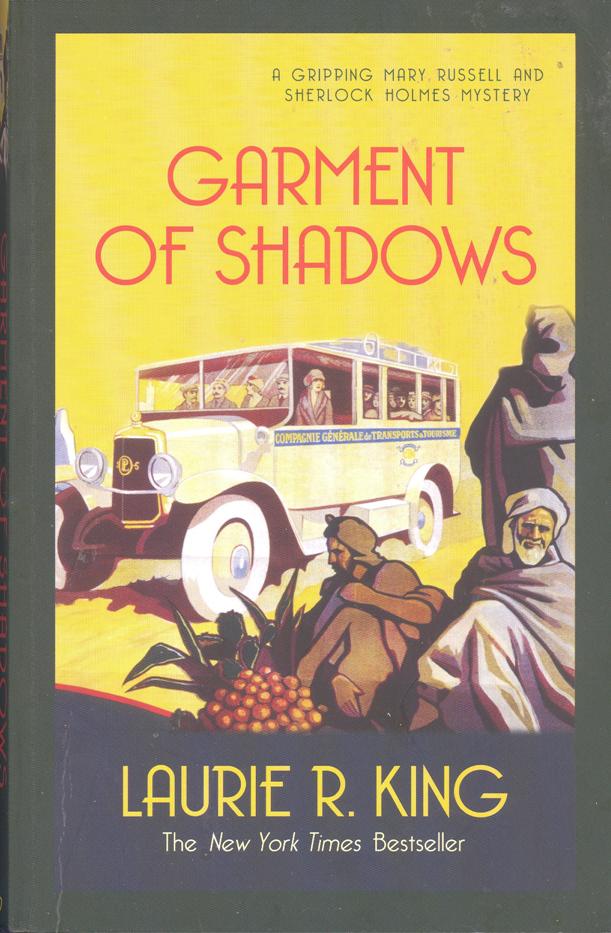
I read this book in March, 2020.
This is book 13 in Laurie King's stories about Mary Russell and her husband the great Sherlock Holmes. Laurie has certainly done her homework, and here we get a history lesson about Morocco, the proud Berber nation - the Moors conquered Spain, built the Alhambra, etc, then were expelled - and a tour of Morocco, and the very ancient town of Fez, all as it was in 1924. Six factions were then fighting over the country. France and Spain both had colonies there. France wated peace and progress, Spain wanted revenge on the Moors. Germany wanted to mine rich iron ore deposits. Britain had a colony in Gibralter, and wanted to retain the status quo across the straits of Gibralter. Add two locals to the fight who each wanted to expel the French and Spanish - the Emir Abd el-Krim, who headed the Rifi rebellion, wanted to set up a republic, and the Emir Raisuli wanted to establish himself as an old style Sultan.
Sherlock's brother Mycroft, who had a finger in lots of pies, had sent two trusted and familiar spies to Morocco - the Hazr brothers Mahmoud and Ali. We met them previously in Palestine in "O Jerusalem" and in England in "Justice Hall" - Mahmoud Hazr had a forner life as an English nobileman, head of the Hughenfort family and estate. Sherlock, Mary, Ali and Mahmoud had shared many an adventure, had saved each other's lives, and trusted each other. But espionage (and Mycroft) is often a dirty business that tests old loyalties. In this story Mary rescues a food and water deprived Mahmoud from a dungeon imprisonment, but later points a rifle at him. But I jump ahead. Although Spain is the more deserving target, Adn el-Krim is about to turn his Rifi rebellion warriors against France, and the French Resident General in Morocco is Marechal Lyautey, who just happens to be Sherlock's cousin. There are spies everywhere ! Who can be trusted ? In particular, is Youssef the old, trusted faithful servant trustworthy ?
The story opens with someone whom we recognise as Mary Russell, regaining consciousness in an unknown bed in an unknown hovel. Worst of all Mary does not know who she is - amnesia due to a head wound - but she feels driven to escape that room, and wander lost in the back alleys of Fez. Mary and Sherlock had separated days previously - Mary to act in a film (!), and Sherlock to visit his cousin Lyautey. They were to rendezvous at the film location, but Sherlock arrived to find his wife missing. Apparently a young mute arab boy (Idir) had been seen with Mary and she had gone off with him. So we have Mary wandering about gradually recovering snippets of memory, and Sherlock desperately trying to find her. Each meets the Hazr brothers - Ali is a spy in Raisuli's camp, and Mahmoud a spy in that of el-Krim's.
A secret meeting has been arranged between the French (Lyautey) and the Rifi (el-Krim). Each has to trust the other, and Sherlock and Mary have to ensure the meeting takes place (but Mary is missing, wandering about disguised as a man, and has lost her memory, how can she help ?)
And so a terrific story unfolds, with many a great danger and miraculous escapes. Mary and Sherlock do meet, but Mary does not recognise Sherlock - although she feels somehow she can trust him. Later Sherlock tells Mary she is his wife. How can Sherlock share a bedroom with a woman who does not know him?
Mary and Sherlock are betrayed by a traitor in Marechal Lyautey's household and captured. A lot, lot later, when the traitor is eventually exposed Mary begins to doubt that this traitor has the ability to concoct such a multi layered devious scheme. Whom do we know back in London with such ability ? And once again this person is not to get his own way - frustrated indirectly by Mary Russell.
The author adds an historical note at the end of the book. The French and the Spanish united to quell the Rifi revolt. Emir el-Krim was exiled to Reunion, a french island, but escaped, and was given sanctuary in Egypt where he died some 40 years later in 1963.
Links to author index and home page
| Laurie R King Heading | Author Index | Go to Home Page |
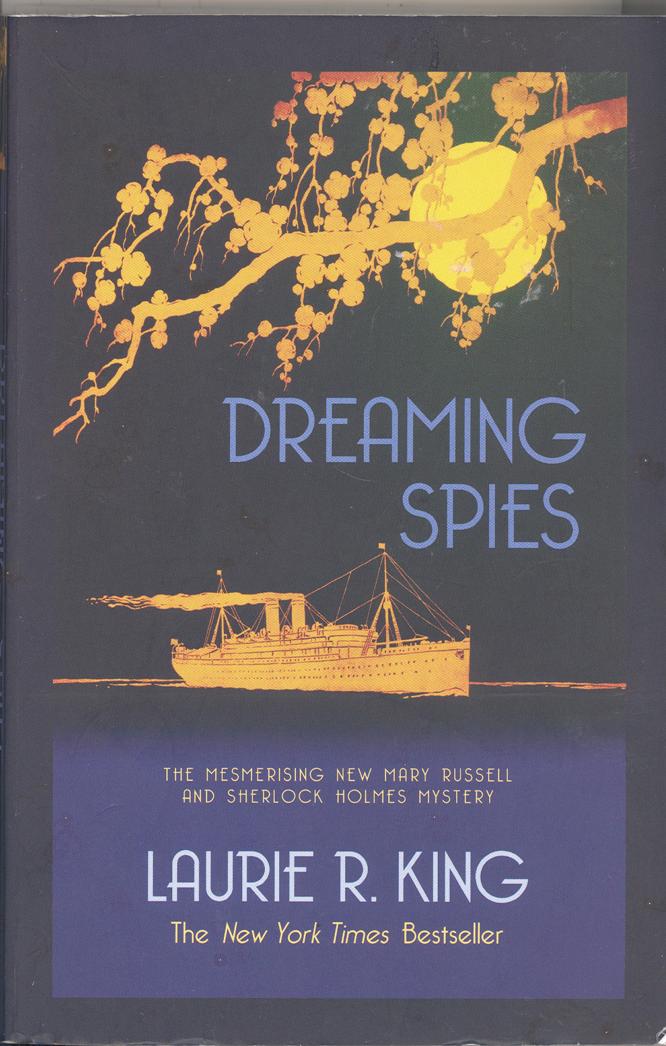
I read this book in December, 2020.
This is book 14 in a series I would not expect myself to like - Sherlock Holmes befriends, apprentices, and marries a young American heiress Mary Rusell - but somehow it works, stays true to Sherlock Holmes, and I like it. For a long time I thought the title of this book was "Dreaming Spires" - a reference to Mary's old University of Oxford. I got that wrong, but there are strong Oxford connections in this book. Mary now has a house there, with a live in house keeper, Miss Pigeon, who lives in an annexe. The house was previously owned by one of Mary's former dons, who died. Mary lets Miss Pigeon know when she will be there, and Miss Pigeon gets in food, airs the house, and Mary finds the place warm and welcoming.
It's 1925, and Mary and Sherlock have returned from their adventures to their Sussex Downs house (and Mrs Hudson). There they find a strange, imposing rock with chrysantium carvings in their garden, delivered by four Orientals in their absence. They last saw this rock a year ago in the Emperor of Japan's garden. It's a thank you gift. What did they do to deserve such a gift, we wonder ?
Now we are back to 1924, and Mary and Holmes are waiting departure of their liner sailing from Bombay to Kolbe, Japan - all as part of their leisurely trip to America. The liner has been held up waiting for some important passengers, and soon Lord James Dudley, his wife ,and his son Thomas turn up. Mary and Holmes had been doing a job for Mycroft. Also boarding is a young Japanese girl , Haruki Sato, daughter of a famous acrobat to the court of the Emperor of Japan. We later learn that Haruki is a lot more than that - she is a secret, deadly ninja "warrior." Holmes had come across Dudley before, does not like him, and suspects he is an evil blackmailer, responsible for so much misery and so many ruined lives. He determines to keep an eye on him. It soon becomes clear that someone else is keeping an eye on him too - Haruki - and this is how they discover she is a ninja. Later we will hear a lot about Japanese 1920's society and culture. It is a country driven by status, with the Emperor at the peak, as a god like deity. The Samurai warriors live and die by the code of honour. The ninja forsake personal honour in the devoted service of the Emperor. Haruki's father, Sato-san, is also a ninja. The Sato clan live quietly, modestly, and secretly, ready to be called on and do impossible things with life long acquired skills. Why on earth do they need Sherlock and Mary ? I should add that I am writing this as if I had not read the final chapter of the book, where there is a great surprise that changes everything.
Holmes beats the card cheating young Thomas Dudley at cards, winning a lot of money which he will donate to charity. Once in Japan, it seems that Haruki has set Holmes and Mary a challenge - to get to a target destination somewhere in a little village of Mojito-joku - but to travel humbly spending only a few low value coins, soaking up and growing to understand and love the customs of rural country life en route. Holmes and Mary travel as Buddist students. After adventures and once there, they meet the regent Emperor of Japan - a rare honour to even be in the presence of a deity, let alone share a bath with him. We now learn why Holmes and Mary have been contacted. Years ago, the regent, Prince Hirohito had given a famous book of illustrated Basho poems to the King of Britain, but it was a state treasure, and not really owned by the regent - i.e. not his to give. The book also had a state secret document hidden in the binding. Mary and Holmes are required to help recover the book - and it suits Holmes to agree as he wants to stop Dudley and his blackmail.
The story now takes off. Dudley, the blackmailer, will die for his crime of blackmailing the emperor of Japan, and threatening to expose the book. However, was Dudley the Blackmailer ? As part of their initation, Holmes and Mary had to fight Haruki and Sato-san in a pitch black room. Surprisingly, Mary beats Haruki, a ninja warrior, because Haruki had underestimated her opponent. The book is recovered , but not by Holmes and Mary. Nevertheless, they earn the gratitude of the Emperor of Japan.
Now it is back to 1925, in Oxford - and a wounded Haruki turns up at Mary's Oxford house. The recovered book was a forgery - a new blackmailer wants £100,000 (and this is 1925) for the original. But how many copies are there, and is it a copy that is in the Bodlian library in Oxford. Holmes calls in one of his old street urchins, the now grown up and married Billy Mudd. Holmes and Mary want to find the fence Bart Collins who was used by the Oxford book restorer Mr Bourke.
It's a great story, and eventually Holmes and Mary prevail, and then we have everything turned on it's head in the surprise climax. Just who was underestimating whom ?
I had one criticism. I thought there was just too much repetitive detail about Japanese life and customs in the middle section of the book - the point seemed to be laboured - but otherwise I thought it a terrific story. Laurie King goes from strength to strength.
Links to author index and home page
| Laurie R King Heading | Author Index | Go to Home Page |
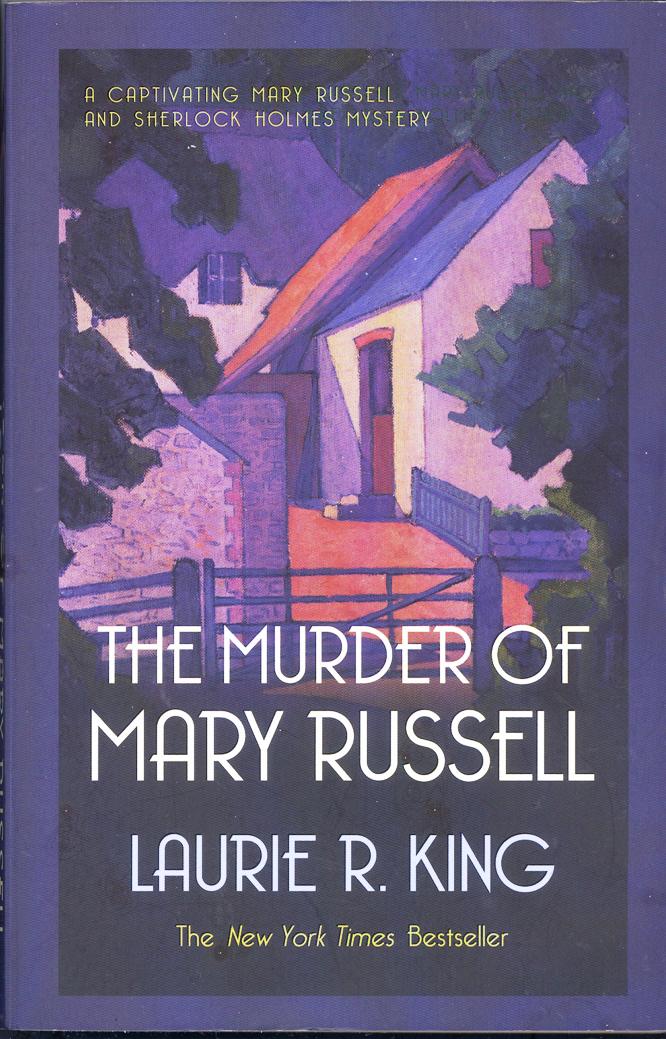
I read this book in February, 2022.
This is book 15 in that wonderful feat of sustained imagination that comprises the Mary Russell meets Sherlock Holmes mystery series. Here Laurie King invents an amazingly detailed whole life story for Sherlock's now aged housekeeper Mrs Clara Hudson, complete with dates. Up to now, Mrs Hudson has just been a constant background presence. The book opens with Sherlock away, and Mrs H. out shopping, so Mary is all alone when she opens the door to an Australian male stranger. He says he is Samuel Hudson, looking in on his mother Mrs Hudson. Mary knew that Clara had a "nephew" / son in Australia, but not much more. It is raining, so she invites him in. He strolls about looking at everything. She goes to make tea, but when she returns she faces the barrel of a drawn revolver, and Samuel is a man full of hatred ! Mary plays along, looking for an opportunity to strike, but when it seems Samuel has come to kill his mother, whom he has called a thief, criminal and murderer, Mary draws out her hidden dagger, and launches herself at Samuel. Later that day, Mrs H. returns to find Mary missing, thick bloodstains on the floor, and marks where something has been dragged away. She phones Billy Mudd, and asks him to tell Sherlock. She also phones the police, and Inspector Lestrade (Jnr) turns up on reports that Sherlock Holmes's wife has been murdered. Sadly she fails to secure the crime scene and any clues for Sherlock - the police are everywhere, and even start to wash away the bloodstains before she stops them.
At the same time as these and later events are unfolding, we learn of Mrs Hudson's life story. Clarissa Hudson was born in Edinburgh. Her mother Sally Rickets had lived and worked there as governess to a family, and moved to London when they relocated. There she met an ex-sailor, James Hudson. They got married, she got pregnant, the baby died, and James went off to get drunk. When he returned days later, Sally was very ill, and delirious. James had been a member of a criminal gang, and, to pay for a good doctor, has to borrow money from the gang leader - "The Bishop." James steals, owes money, and fleas to Falmouth with his recovered but now pregnant wife. With the net closing in on him, James returns to sea. The boat goes down, Sally loses her job, and she returns to Edinburgh where she has a mum, dad, and sister Alice.
Months later, Sally hears from James - alive in Sydney. He wants her to borrow money from Alice, and join him. Sally gets Alice to look after Clarissa, sets herself up, steals from her father, and so deliberately gets herself transported to Australia with her baby Clarissa. There she is a employed as servant to James Hudson - but they live as man and wife. Baby Alicia (Allie) is born, and then a boy, Jamie, whom Clarissa cares for, but sadly Jamie and Sally die. Both girls are starving, neglected terribly by their father, and living in squalor, but Clarissa looks after Alicia, and sends her to school. Alicia then teaches Clarissa what she has just learned. Clarissa has to steal to feed Alicia, and is caught, but by a friendly policeman. Throughout Alicia demands everything, but is never grateful. But James discovers Clarissa's gift for acting and accents, and uses them in money making schemes, and various scams. Clarissa knows it is wrong, but she is very good at it, they have food, and she can feed Alicia. They prosper. Clarissa grows into womanhood, is almost raped, and her father buys her a small pistol, a Derringer, and teaches her how to use it. She later does have to use it, twice (amazingly to kill her father and I won't say who else !) When 20, James Hudson takes her back to London, leaving Alicia behind with a rich spinster.
James has no social skills, so Clarissa (22), now a beautiful young woman, needs a sponser to break into top society. James goes back to "The Bishop", accepts a beating, and borrows money to finance Clarissa - expensive clothes, etc. All is sort of going well, Clarissa is about to nab a rich, titled husband, but then the roof drops in. Clarissa falls in love with the Hon. Hugh Edmunds, Earl of Steadworth, sleeps with him, becomes pregnant, and eventually Samuel is born. Now separated from her father and abandoned by Steadworth, Clarissa needs a partner for her scams to get some money, goes to the Bishop, and meets Billy Budd (6). They work well together, bond, she cares for him, and sends him to school. Things go well. One day, she notices a young man watching her. He is a young Sherlock Holmes, looking for James Hudson whose blackmail he says has caused the death of a friend's father. James is extracting money from now respectable ex shipmate convicts Trevor and Beddoes. Holmes abhors blackmail - it caused the death of his own mother. James contacts Clarissa again, desperately pleading for help. They meet in a lonely secluded cottage in the woods, she pretends to go along with his scheme, but there is a knock at the door. It is young Billy, with Sherlock Holmes. James points a gun at them, Sherlock shields Billy, Clarissa draws her Derringer and shouts no ! There are two shots, Sherlock is wounded, and James Hudson killed. Clarissa, who has saved his life, says she will let Sherlock take her to the police, if he agrees to look after Billy. Sherlock decides on a different sort of justice. They bury James Hudson in the woods. Sherlock says he will pay for Clarissa, Billy and Samuel to go to Australia, but if Clarissa wants to return to England, she must do so alone within a year. Clarissa meets Alicia in Sydney, now married to a good man, Ray McKinnon. Alicia's own baby has died. Clarissa agrees to leave Samuel with Alicia and Ray (she is impressed with Ray). Alicia becomes mother to Samuel, and Clarissa his "aunt". Sadly Ray dies 4 years later, and Samuel is not brought up well.
Back in London, Sherlock pays off "The Bishop", buys 221 Baker Street for Clarissa, and becomes her tenant. Dr Watson is another tenant. Sherlock tells her he will never speak of Clarissa's former life, but coldly says he will never forget. He renames her Clara. Now a sort of private detective, he hires Billy and his street urchins as young helpers - his "Irregulars" - and sometimes uses Clara too. And so a new life begins, Sherlock does his disappearing act 10 years later, but returns, and when he "retires" at 42 to keep bees in Sussex, Clara sells up, gives half to Billy, and joins Sherlock in Sussex as his housekeeper. And then, in 1915, Mary Russell turns up, and makes them both young again !
This then is the summary of Mrs Hudson's life. She has lived for 46 years with Sherlock, scrubbed his floors, cooked for him, but throughout, as he has kept her on the straight and narrow, has he been her friend or her jailer ? Whatever the relationship, there has been a real bond, and Mrs H. has been a mother figure to orphan Mary Russell.
I have gone into Clara Hudson's life in some detail, (but Laurie King does it better), because this explains all the events that unfold. Years ago, James Hudson's boat had sunk following a crew mutiny. Fellow survivors included "Trevor" and the bank swindler Jack Prenderegast (later calling himself Beddoes). Prendergast claimed to be worth a fortune, but did this "treasure" survive. Samuel later thought it did. And so a complicated story unfolds, Mycroft is involved, and eventually Mary has apparently been killed. It's a terrific story well worth reading, and there are surprises aplenty right up to the very end. Mrs Hudson will not make it into the next book - I will need to read on to see if Mary and Sherlock employ a new housekeeper.
Links to author index and home page
| Laurie R King Heading | Author Index | Go to Home Page |
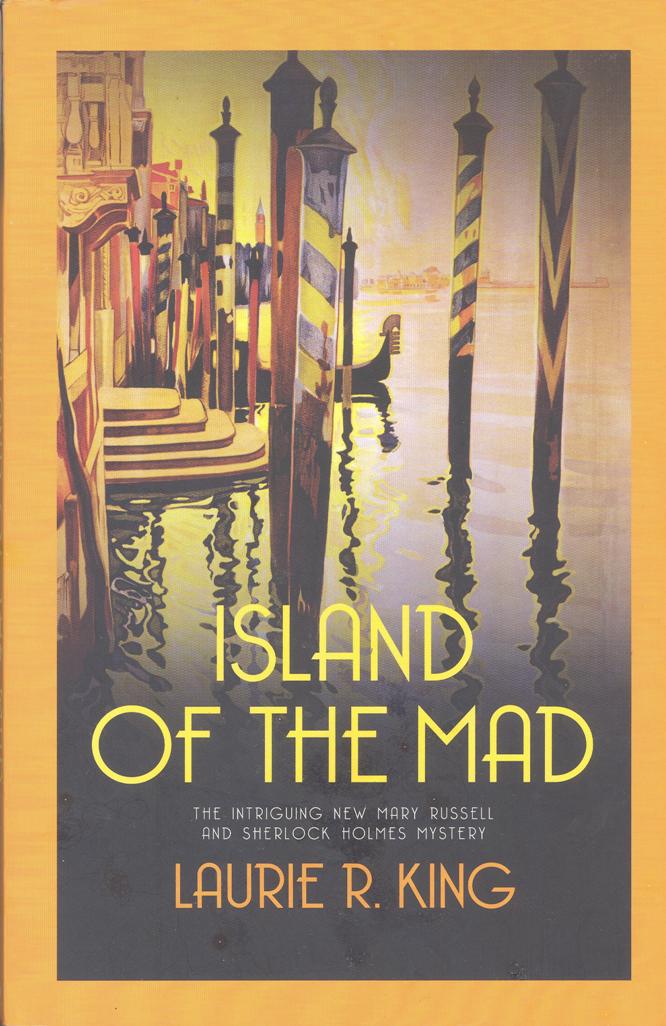
I read this book in November, 2022.
This is book 16 in the Mary Russell / Sherlock Holmes series. It's usually a very good series, but sadly I didn't think this book was up to the normal Laurie King standards. I like historical fiction to have firstly a strong main story, with the secondary historical place and time an interesting background . But here, most of the book concentrates on the background, and the crime plot is somewhat feeble. I read this book en route to and on arrival in Sydney. Maybe I was just jet lagged, and not being fair to the author. But simply, the main plot is someone's maiden aunt goes missing, and Mary and Sherlock set off to find her. And this is against a background of searching in the Bethlehem Hospital for the Mad (Bedlam), of searching amongst the homosexual, lesbian, and bi-sexual chic set of Venice, and finally against the rise of General Mussolini's Fascists in Italy.
Let's introduce the main new and old characters, starting with the new. There were three childreen born into the Selwick estate. Vivian was the youngest, Edward was 16 when she was born, and Thomas 14. Thomas ran the estate well, but when he died, Edward had to give up the high life of London, and return to Selwick Hall to run things. He was hopeless, lost money, and times are now hard. Thomas had married Dorothy, and they had a daughter Veronica - i.e. Mary's friend Ronnie from her Oxford days. Ronnie married Miles Fitzwarren, and they had a son Simon. Sadly, Miles was killed by a sniper bullet and Ronnie is now in dire financial straits. Within the old characters we have Mrs Hudson absent, possibly in Monte Carlo. Her story was told in "The Murder of Mary Russell." Her resentful son had turned up, tried to kill Mary, and Mrs Hudson saved the day, but had to flee, rather than languish in prison. Sherlock's brother Mycroft is still the international secret service supremo, and Sherlock's ex "special" Billy Budd is still called upon to help out.
Now to the plot. Ronnie phones Mary to ask for her help. Ronnie's aunt Vivian has gone missing, along with some family jewels. Can Mary help find her ? On Edward's return, Vivian had been moved to the East Wing of Selwick Hall. She became erratic and eccentric, weeping and nervous, and then she tried to kill Edward with a poker. She was in and out of a succession of private clinics, but then she tried to kill herself with a knife, and was committed to Bedlam. Years later she was judged much better, and allowed out for a week to attend her brother's birthday pary, but accompanied and supported by Nurse Trevison. On Thursday of that week Vivian said she was unwell, and returns to Bedlam with Trevison. However neither turn up, and a lot of Selwick jewellry is missing.
Mary asks Sherlock to help find Vivian, and soon they learn that Vivian has withdrawn a lot of her inheritance from the bank. This annoys Edward - he thinks her money is Selwick money, and, in short, his, as he is head of Selwick. To get at Vivian's records, held in Bedlam, Mary has herself committed there - a bit drastic, I thought. We then hear lots and lots about life in Bedlam, apparently not as bad as it's reputation. The first real clue is that Vivian may be a lesbian, and may have gone to Venice. Accordingly, Mary sets out to visit Venice, a place she knows well. Sherlock says he will come too - his brother Mycroft has asked him to find out all he can about the rise of the Fascists in Italy.
We now have page after page of tributes to Venice. Apparently, the Jews and the Venetians had got on well, in a business relationship enduring for centuries. Mary is mostly captivated by Venice - "a place whose meaning you will never know, a work of art to be admired forever." Holmes dislikes the place - everyone wears a mask, you never know what a Venetian is thinking, it's a place where yes can mean no. Mary and Sherlock go their separate ways to find Vivian. Mary joins the smart, gay set, getting befriended by Elsa Maxwell, their unofficial leader. One of this set proves very helpful - the honourable Terry - whose boat Mary "borrows". Cole Porter is in town too, attracting a following of the cream of Venetian Society. Sherlock buys a violin, auditions for Cole, and he too is in. Which set has or might atract Vivian ?
Behind all the party going facade, the Fascist Black Shirts are taking over, in a rule of terror. You cannot report them to the police - they are the police. Amazingly, they seem to have attracted Edward to leave Selwick and travel out to Venice.
Vivian is only a few years older than Mary. She was in Bedlam on a voluntary basis, and could have left any time she wanted (subject to 72 hours notice). She had been invited to stay with Ronnie and Simon, but Vivian declined. She wanted to stay in Bedlam - "I am safe there."
In the climax we learn why Vivian attacked Edward, and why she feels safe only when away from Edward. Mary and Sherlock also set up a brilliant blackmail plot.
And now, as I always, always say - I will leave you to read the book for yourselves - and hopefully like it more than I did.
Links to author index and home page
| Laurie R King Heading | Author Index | Go to Home Page |

I read this book in March, 2023.
This is book 19 in Laurie King's brilliant Mary Russell / Sherlock Holmes series, and I am a real fan. This particular story is about two treasures, and one old woman with a surprising back story - Mrs Hudson. I usually start these write ups by introducing the main characters, but here I will give a Mrs Hudson recap. Clarissa Hudson was born in 1857 - her story is told fully in "The Murder of Mary Russell." She is the daughter of Sally Pickets and James Hudson, and was taken by Sally to Sydney where sister Allie was born. When Sally died, and James Hudson badly neglected his daughters, young Clarissa rose to the occasion, lied and cheated, and generally lived off her wits to provide for little Allie. This required a lot of talent and eventually James realised he could use his daughters skills to make money. When she is 20 Clarissa returns to London with her father, again scheming and cheating. Disastrously she falls for the Earl of Steadworth - thus ending James Hudson's meal ticket, but Clasissa is now pregnant with a baby son, Samuel. She returns to Sydney, to leave Samuel with her sister Allie who will raise the boy as her own. Back in London again, and up to her old tricks, justice finally catches up with Clarissa in the shape of a young Mr Sherlock Holmes. Given an ultimatum, she agrees to abandon her former life, is now to be known as Mrs Clara Hudson and runs a house in Baker Street for Mr Holmes giving many, many years of faithful service. When Holmes retires to Sussex, Mrs Hudson goes too, as his housekeeper. Mary Russell turns up in 1915. Years later, with Mary married to Sherlock, Samuel turns up and almost kills Mary. Mrs Hudson saves Mary, but now has to to flee the country rather than risk imprisonment. She cannot say where she is going, but she hints to Mary that Monte Carlo might appeal. In short, Mrs Hudson has a surprising history that is scandalous, adventurous, and criminal.
This story opens with a flashback to 1877, Clarissa is 20, beautiful and at a Ball in London, and meets a handsome young Russian called Zedzed. Later this Russian - Sir Basil, Count Zaharoff - is a powerful feared, unscrupulous munitions supplier, the richest, but most dangerous man in Europe.
It's 1925, and Mary and Holmes are in Venice. Holmes has business to attend to, but Mary hears that her new chum the Hon Terry McClintock is sailing to the French Riviera near Monaco, and so agrees to tag along - hoping perhaps to come across Mrs Hudson. Agreeing to stay on for a few days with her sailing companions who are booked in to a half deserted off season hotel - the Hotel Du Cap - they put ashore at the port of Antibes. There they meet Terry's artist friend Gerald Murphy, and his Greek friend Nico Cassavettes. Mary also meets Gerald's wife Sara, their family, and their amazing temporary nanny - Mrs Hudson herself !
Eleven weeks ago, Mrs Hudson (69) arrived in Monte Carlo to see a very dear old friend, whom she had last seen 49 years ago - Lillie Lantry. She wants Lillie's help to introduce her to a person with banking skills. She has "papers" she needs help with. These are bearer bonds, and so we meet the first of two treasures behind this story. 70 years ago, the embezzler Jack Prendergast converted his $250k fortune into bonds - lost, but discovered by James Hudson / Mrs Hudson.
Mrs Hudson has a consultancy job, making the Principality attractive to the modern generation. Mary bonds with Sara Murphy, but is a little wistful, seeing in Gerald and Sara's love of their children a childhood that Mary never had. Lillie introduces Clarissa to a Russian Yevgeny, Count Vasilev. This Vasilev is great chums with the notorious Sir Basil Zaharoff. Mrs Hudson is most anxious to cash her 4 bonds before Sherlock Holmes turns up - as he surely will. She wants to be able to tell him she is living an honest life , and has not relapsed into her old ways. She gives Vasilev one bond to cash, as a test. He later tells her success - the money is now in his bank account in San Remo (Italy), and they must go there to get it. Alas , it's too much money, too great a temptation. Vasilev plans to keep the money - and very much later by tossing her overboard from his friend Zaharoff's yacht.
Holmes meets Mary in Monte Carlo - knowing she was going there, he got there first and waited. He is staying at the Hermitage Hotel. The munitions dealer Zaharoff is in town (owns the town) and has been seen talking to Mrs Hudson. Holmes fears she may have reverted to her old ways. Next they meet the Hon Terry McClintock bursting to tell them the latest scandal - Mrs Hudson has been arrested for murder. She was found in her room, gun in hand, and a dead man (Nico Cassavettes) at her feet. All this is Vasilev's first attempt to get rid of Mrs Hudson. Inspector Jourdain is in charge of the case. Holmes and Mary swing into action. The blood on the floor had started to dry, and so the act was several hours earlier. Mrs Hudson now has an alibi - she was at a dinner then with Lillie, Sir Basil Zaharoff, and Count Vasilev. How fitting, that Vasilev, trying to get rid of Mrs Hudson, now provides her alibi!
Nico had a shady history and links to the Crovelli family of smugglers. Mrs Hudson and Nico are both renting accommodation from Mrs Crovelli. Mary, tries to discover where Zaharoff lives, and is told he has an office in the hotel. She goes there, but on entering this office is greeted by Count Basil Zaharoff himself, pointing a gun at her. She tells him that as the police are afraid to interview him, she then must, as an old friend of Clarissa Hudson.
Rafe Ansley, the sculptor, will be pouring some bronzes at the local M.Ferriat foundry, and lots of guests are invited. An aside : - I think the clue is in the title to this book - Riviera Gold, and now we have a foundry used for smelting ! And so we have the second treasure. Mary offers to help Rafe who has lost his assistant (Nico), and thus she gets to search his flat. Whilst doing so, Count Vasilev walks in. Calmly, Mary makes him a cup of tea.
Inspector Jourdain explains that he cannot move against a powerful figure like Zaharoff, as Monaco is a small country, and has to compromise and do balancing acts simply to exist.
Holmes is worried about what danger Mary may have got herself into, and so he turns to his brother Mycroft for information and help. The party viewing the bronze pouring is joined by the famous Picasso whom Mary met in Paris. And now, the story really takes off. Mrs Hudson sails off with Vasilev on Zaharoff's yacht to get her money. Lillie is alarmed at the risk Mrs Hudson is taking, especially as Zaharoff is not on his yacht. She fears Vasilev will get the money, and then throw Mrs Hudson overboard. She alerts Mary, who sends Terry's friend Johnny Perez after them in his sea plane. She and Terry "borrow" a sea racing boat (with an aeroplane engine) and rush to rescue Mrs Hudson.
There are a lot of climaxes. Will they rescue Mrs Hudson ? Will Sherlock rescue his wife ? Throughout, Mrs Hudson keeps her cool, and negotiates with Vasilev. She tells him he is finished, she has powerful friends of which he knows nothing, but if spared, she will look after Vasilev's invalid daughter Natalie, in a mental hospital in America. Poor Natalie is a Russian traumatised by the revolution atrocities - she saw her mum and family killed in front of her.
Finally, we are back to Mrs Hudson. She had told Lillie she had never been happier than being back in Monte Carlo with Lillie's friendship. Mary finds the remaining of Mrs Hudson's Prendergast bonds from the clue - "hiding in plain sight". She tells Mrs Hudson she must tell Sherlock, but kindly adds "but not quiite yet". Mary then visits Zaharoff, and tells him his story as if happening to a third party, but she too says Mrs Hudson has powerful friends, and their cards are in the bottom of a box she hands to Zaharoff.
As much as anything, this series is a love story - that of Sherlock and Mary. When he thinks Mary is at risk, Sherlock tells Mycroft to reply in 8 hours, not 12, and he threatens an international incident as he shouts at Inspector Jourdain to get him to act and help rescue Mary.
Of course there is gold - Riviera Gold ! A bitter sweet thought - in making it safe for Mrs Hudson in Monaco, Mary lowers the chance of Mrs Hudson ever returning to Sussex, and things getting back to normal.
Some final thoughts / highlights for me :- Mrs Hudson says "An act of kindness can be a powerful weapon if used at the right time," and thanking Lillie for her continued friendship, Mary recoiling from a casino visit when she experiences the addiction of gambling, and Holmes distraught at Mary bearding the bear Zaharoff in his den. He is out of your league, and possibly mine. Finally I should add that throughout this story, Mary and Sherlock never reveal who they are, but keep the false Venice names they used in the previous story. Mary does try to tell Sara, but she is not believed.
Links to author index and home page
| Laurie R King Heading | Author Index | Go to Home Page |